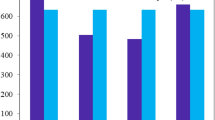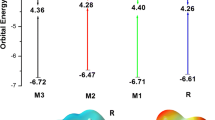Abstract
Nowadays, scientists are trying to develop low-cost fullerene free acceptors for small organic photovoltaic cells in order to overcome the limitations of fullerene derivatives. Current research work deals with theoretical study on three non-fullerene acceptors based on indaceno, dithiophene core, and thiophene bridge units linked with dissimilar end non-fullerene groups which act as strong acceptor moieties. Different optoelectronic characteristics of the designed molecules were calculated and compared with the reference compound R (indaceno dithiophene–based fused ring acceptor) which is recently reported. Results shows that C2 and C3 exhibit broad absorption spectrum and lower band gap whereas C2 and C1 exhibit highest open-circuit voltages VOC value with B3LYP and MPW1PW91 functionals respectively as compared with the R. All designed molecules have high dipole moment values, lower value of hole reorganization energy λh than electron reorganization energy λe which reflects that our designed acceptor molecules are good candidates for organic photovoltaics.

Absorption spectra of R and three designed non-fullerene acceptors with strong absorption band in the visible region of solar cells spectrum.





Similar content being viewed by others
References
Ku J, Lansac Y, Jang YH (2011). J Phys Chem C 115:21508–21516
Bagher AM (2014). Int J Renew Sustain Ener 3:53–58
Bai H, Wang Y, Cheng P, Li Y, Zhu D, Zhan X (2014). ACS Appl Mater Interfaces 6:8426–8433
Qiu B, Xue L, Yang Y, Bin H, Zhang Y, Zhang C, Xiao M, Park K, Morrison W, Zhang Z-G (2017). Chem Mater 29:7543–7553
Lin F, Huang W, Sun H, Xin J, Zeng H, Yang T, Li M, Zhang X, Ma W, Liang Y (2017). Chem Mater 29:5636–5645
Chang M, Wang Y, Qiu N, Yi YQQ, Wan X, Li C, Chen Y (2017). Chin J Chem 35:1687–1692
Q. Wang, Y. Li, P. Song, R. Su, F. Ma, Y. Yang, Polymers, 9 (2017) 692
Bari A, Irfan M, Zara Z, Eliasson B, Ayub K, Iqbal J (2017). J Mol Struct 1143:8–19
Bourass M, Amine A, Hamidi M, Bouachrine M (2017). New organic dyes based on phenylenevinylene for solar cells: DFT and TD-DFT investigation. Karbala International Journal of Modern Science, 3(2):75–82
Wang J-L, Xiao F, Yan J, Liu K-K, Chang Z-F, Zhang R-B, Wu H-B, Cao Y (2016). J Mater Chem A 4:2252–2262
Manzoor F, Iqbal J, Zara Z, Eliasson B, Mahr MS, Ayub K (2018). ChemistrySelect 3:1593–1601
Bourass M, Benjelloun AT, Benzakour M, Mcharfi M, Hamidi M, Bouzzine SM, Bouachrine M (2016). Chem Cent J 10:67
Zara Z, Iqbal J, Ayub K, Irfan M, Mahmood A, Khera RA, Eliasson B (2017). J Mol Struct 1149:282–298
Bourass M, Benjelloun AT, Benzakour M, Mcharfi M, Jhilal F, Serein-Spirau F, Sotiropoulos JM, Bouachrine M (2017). J Saudi Chem Soc 21:563–574
Turkoglu G, Cinar ME, Ozturk T (2017). Top Curr Chem 375:84
Ali U, Javed A, Tallat A, Iqbal J, Raza A (2019) Molecular designing of four high performance pyrazine-based non-fullerene acceptor materials with naphthalene diimide-based small organic solar cells. J Mol Model 25(2):50
Acknowledgments
The authors acknowledge the technical support provided by the Department of Chemistry, University of Agriculture, Faisalabad, 38040, Pakistan.
Funding
The study was financially supported by the Department of Chemistry, University of Agriculture, Faisalabad, 38040, Pakistan.
Author information
Authors and Affiliations
Corresponding authors
Ethics declarations
Conflict of interest
The authors declare that they have no conflict of interest.
Additional information
Publisher’s note
Springer Nature remains neutral with regard to jurisdictional claims in published maps and institutional affiliations.
Electronic supplementary material
ESM 1
(DOCX 551 kb)
Rights and permissions
About this article
Cite this article
Ajmal, M., Ali, U., Javed, A. et al. Designing indaceno thiophene–based three new molecules containing non-fullerene acceptors as strong electron withdrawing groups with DFT approaches. J Mol Model 25, 311 (2019). https://doi.org/10.1007/s00894-019-4198-x
Received:
Accepted:
Published:
DOI: https://doi.org/10.1007/s00894-019-4198-x




